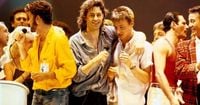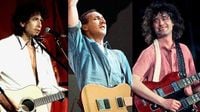Forty years ago, on July 13, 1985, the world witnessed what was then the most ambitious concert event ever staged: Live Aid. Conceived and organized by Irish musician Bob Geldof and his collaborator Midge Ure, the event was a groundbreaking effort to raise funds and awareness for the devastating famine in Ethiopia, which had claimed up to 1.2 million lives. Broadcast live across the globe, Live Aid featured simultaneous concerts at London’s Wembley Stadium and Philadelphia’s John F. Kennedy Stadium, along with performances in Europe, Australia, and Japan, captivating nearly two billion viewers in 169 countries.
Live Aid was more than just a concert; it was a global jukebox, showcasing some of the biggest names in music at the time. From Queen’s electrifying set to the surprise reunion of Led Zeppelin, and the legendary performances by The Who and U2, the event brought together a dazzling array of talent united by a humanitarian cause. The concerts raised approximately $140 million for the Band Aid Charitable Trust, which Geldof had launched with the 1984 charity single "Do They Know It’s Christmas?" The impact of Live Aid went beyond fundraising; it galvanized public opinion, influenced political discourse, and inspired a generation to believe in the power of music to effect change.
In Philadelphia, the atmosphere was electric but sweltering. The temperature soared to 95 degrees Fahrenheit, with the concrete stadium amplifying the heat. Judas Priest’s Rob Halford recalled the experience as "boiling hot," especially challenging for performers clad in leather. Despite the heat, the energy was palpable. Halford fondly remembered meeting folk icon Joan Baez backstage, who told him, "My son has told me that he prefers your version to his mum’s" of her song "Diamonds and Rust." Such moments underscored the camaraderie and mutual respect among artists united by the cause.
The lineup in Philadelphia was a mix of rock, metal, blues, and jazz luminaries. Led Zeppelin’s reunion was one of the most talked-about moments, though not for reasons of triumph. The band’s three-song set, including "Rock and Roll," "Whole Lotta Love," and "Stairway to Heaven," was plagued by technical difficulties and lack of rehearsal. Robert Plant later described the performance as "horrendous," while Jimmy Page admitted to being in "total panic." Drummers Tony Thompson and Phil Collins struggled with coordination, and stage monitors failed, leaving the band out of sync. The performance was so disappointing that it was excluded from Live Aid’s official DVD release. Yet, despite the flaws, the reunion remains a significant historical moment, emblematic of the event’s scale and ambition.
Meanwhile, The Who made their first appearance since their 1982 breakup, delivering a spirited four-song set that included "My Generation" and "Won’t Get Fooled Again." Although guitarist Pete Townshend later accused Geldof of pressuring the band into performing, the set was widely praised for its energy and passion. The band also joined Paul McCartney for the event’s closing number, "Let It Be," symbolizing unity and hope.
Bob Dylan closed the Philadelphia show with Keith Richards and Ron Wood, performing "Ballad of Hollis Brown," "When the Ship Comes In," and "Blowin’ in the Wind." However, their performance was marred by sound issues, including a stage curtain blocking amplifiers and a broken guitar string. Dylan’s controversial remark suggesting some Live Aid funds be used to pay American farmers’ mortgages drew criticism from Geldof, who felt it showed a "complete lack of understanding" of the event’s purpose.
In London, the festivities kicked off with Status Quo, described by Geldof as "ordinary blokes with long hair and denims," setting the tone with John Fogerty’s "Rockin’ All Over the World." The London lineup featured iconic performances by Queen, David Bowie, U2, and George Michael, among others. The late Diana, Princess of Wales, and the King, then Prince of Wales, attended the event, underscoring its global significance.
Personal recollections from those who attended or worked at Live Aid reveal a shared sense of unity and purpose. Lucy Swanson, daughter of BBC Radio 1 DJ Annie Nightingale, described the crowd as "amazing," noting the absence of mobile phones and selfies, allowing fans to fully immerse themselves in the moment. Special constable Vivien Harvey recalled the "buzz" and "crescendo" of excitement backstage, with Freddie Mercury hailed as the star of the show. Hospitality staff like Debbie Baxter expressed pride in being part of such an iconic event, a feeling that only deepened with time.
Live Aid’s legacy continued with Live 8 in 2005, another global concert series organized by Geldof to combat poverty. However, Geldof and other artists like Rick Springfield and John Oates express skepticism about the feasibility of a similar event today. Geldof attributes this to the fracturing effects of social media algorithms, which create echo chambers and inhibit collective action. Springfield noted, "I think we are too divided" to rally around a single cause or artist lineup as was possible in 1985. Oates pointed to the dramatic changes in the music and entertainment landscape, citing the impossibility of replicating star-studded collaborations like the 1985 charity single "We Are The World."
Despite these challenges, there remains hope. Halford cited the January 2025 Fire Aid concert for wildfire relief, featuring Billie Eilish, Stevie Wonder, and a Nirvana reunion, as evidence that empathy and large-scale benefit events can still thrive. "There will always be empathy from people," he said, "and in the right hands, maybe another event like Live Aid could take place."
As Live Aid marks its 40th anniversary, organizers Midge Ure and Bob Geldof, along with performers like Bono, Brian May, and Chrissie Hynde, gathered to celebrate the enduring impact of the event through the musical "Just For One Day." Ure emphasized the story’s ongoing relevance, calling it "a story about hope" and a testament to what can be achieved when people come together. He urged the next generation to take up the mantle, saying, "It’s up to you now." Geldof’s tireless activism continues, embodying the spirit of determination that made Live Aid possible.
Live Aid was not just a concert; it was a cultural milestone that redefined the potential of music as a force for global good. Forty years on, its echoes continue to inspire, reminding the world that even in uncertain times, hope and collective action can change the course of history.


